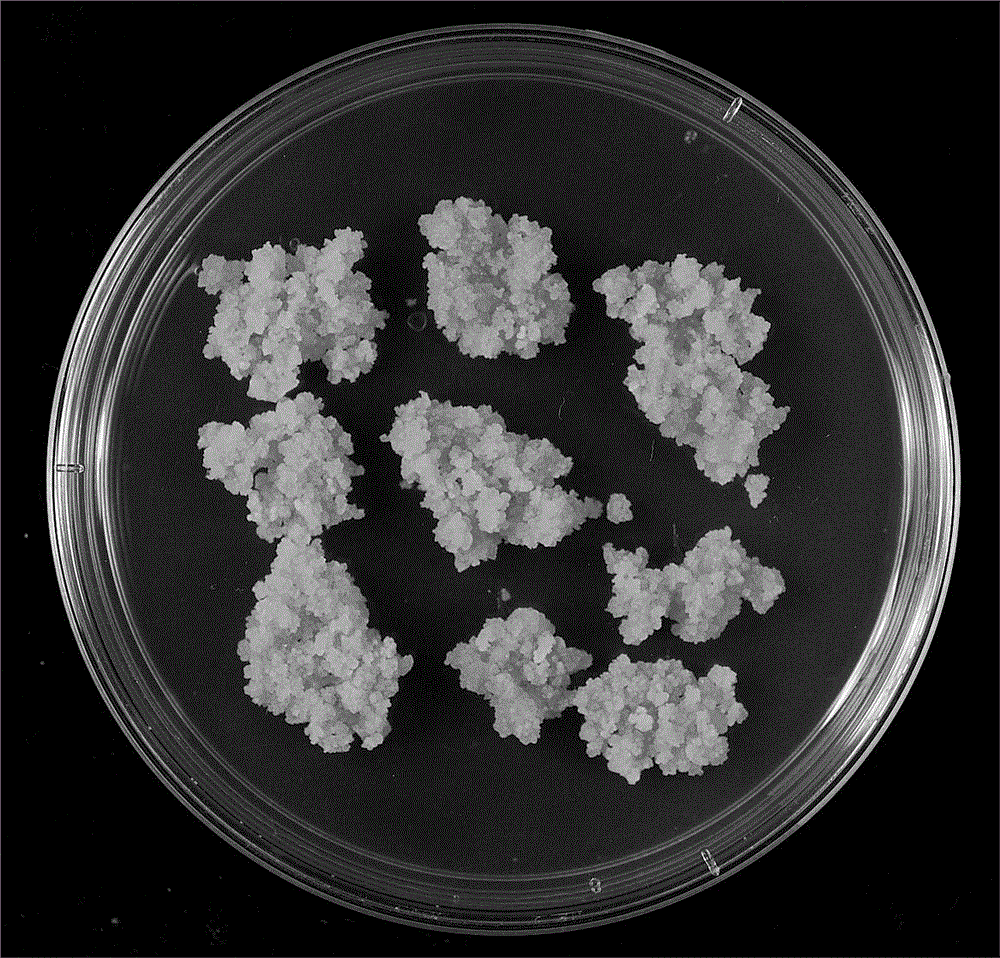Genetic transformation method for panicum virgatum L.
A technology of genetic transformation and willow branch, which is applied in the field of plant bioengineering, can solve the problems that the genetic transformation system has not yet been established and low efficiency, and achieve the effects of ensuring continuous sufficient supply, reducing costs, and high transformation efficiency
- Summary
- Abstract
- Description
- Claims
- Application Information
AI Technical Summary
Problems solved by technology
Method used
Image
Examples
Embodiment 1
[0036] Example 1: The acquisition and propagation of switchgrass type II high-quality embryogenic callus comprises the following steps:
[0037] 1) After sterilizing the mature seeds of switchgrass with 3% (W / V) calcium hypochlorite for 2 hours, wash them with sterile distilled water 3 times (5 minutes each time), then put them in the refrigerator at 4°C overnight, and continue to use them the next day Disinfect with 5% (W / V) calcium hypochlorite for 1.5 hours, then wash 3 times with sterile distilled water (5 minutes each time), inoculate on callus induction medium (MSD5), and treat each seed Numbering, incubator temperature 25±2°C, dark culture for 6-7 weeks, to obtain callus.
[0038] 2) The callus obtained in step (1) was visually selected to be type II high-quality embryogenic callus with light yellow, loose structure and warm luster ( figure 1 ), inoculated on MSD5 medium, preserved and multiplied, the temperature of the incubator was 25±2°C, cultured in the dark, su...
Embodiment 2
[0041] Example 2: The main features of the acquisition of transgenic switchgrass plants include the following steps:
[0042] 1) Store the pMDC100 binary vector ( figure 2 A) Agrobacterium tumefaciens AGL1 Streak inoculation on LB solid medium supplemented with 50mg / L rifampicin and 50mg / L kanamycin, culture overnight at 28°C, then pick a single colony and inoculate in LB supplemented with 50mg / L rifampicin and 50mg / L kanamycin In the liquid medium of mycin, cultivate overnight at 28°C on a shaker (200rpm) to OD 600 reach 0.6, then add acetosyringone to a final concentration of 200 μmol / L, and continue culturing for 2 h to OD 600 Reach 0.8-1.0, 3500rpm, centrifuge at 20°C for 15 minutes to collect the Agrobacterium cell pellet, and use MS3D liquid medium to resuspend the cell to adjust the OD 600 to 0.3.
[0043] 2) Use the Agrobacterium strain prepared in step (1) to co-incubate the high-quality embryogenic callus of switchgrass type II described in Example 1 for 10 m...
Embodiment 3
[0055] Example 3: Molecular identification of transgenic switchgrass plants obtained by kanamycin resistance screening, its main features include the following steps:
[0056] From the transgenic switchgrass plants grown in the greenhouse for 1 month, the top 8-9cm leaves were taken and cut into 3-4cm segments, and the 2×CTAB method was used (Zhang Xiaoxiang et al., A modified CTAB method for rapid extraction of wheat genomic DNA, China Agricultural Science Bulletin, 2012,28:46-49) extract DNA, and perform exogenous gene ( nptII ) PCR amplification to identify positive transgenic switchgrass plants ( image 3 ).
[0057] Described for exogenous gene ( nptII ) The PCR primer sequence of detection is:
[0058] nptIIF: CGTCCTTTGCTCGGAAGAGTATGAA
[0059] nptIIR: GACGCAGAAGGCAATGTCATACCAC
[0060] The amplification condition of PCR is: 95° C., 2 min; followed by 30 cycles, and the condition of each cycle is . 94°C, 30s; 55°C, 30s; 72°C, 30s; finally 72°C, 10min.
[0061]...
PUM
 Login to View More
Login to View More Abstract
Description
Claims
Application Information
 Login to View More
Login to View More - Generate Ideas
- Intellectual Property
- Life Sciences
- Materials
- Tech Scout
- Unparalleled Data Quality
- Higher Quality Content
- 60% Fewer Hallucinations
Browse by: Latest US Patents, China's latest patents, Technical Efficacy Thesaurus, Application Domain, Technology Topic, Popular Technical Reports.
© 2025 PatSnap. All rights reserved.Legal|Privacy policy|Modern Slavery Act Transparency Statement|Sitemap|About US| Contact US: help@patsnap.com



